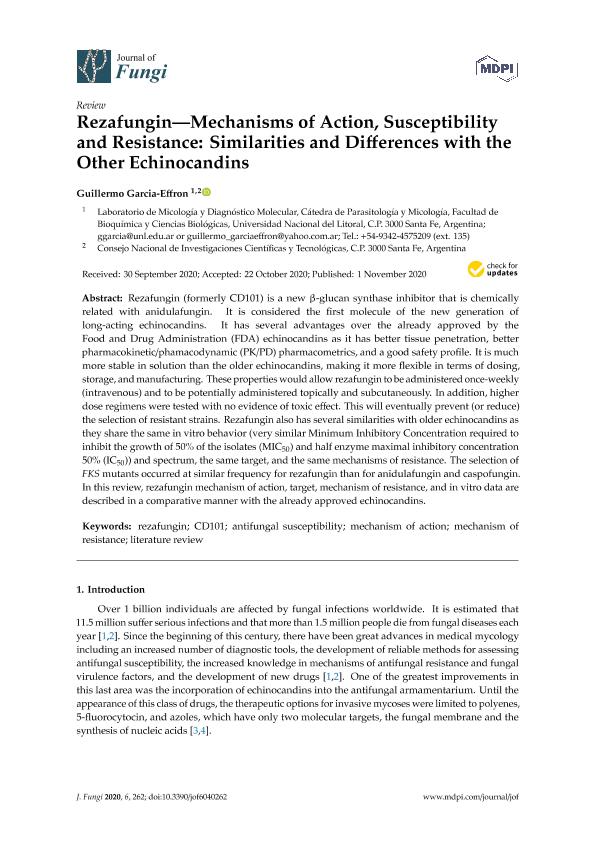Mostrar el registro sencillo del ítem
dc.contributor.author
Garcia, Guillermo Manuel

dc.date.available
2022-09-21T17:23:07Z
dc.date.issued
2020-12
dc.identifier.citation
Garcia, Guillermo Manuel; Rezafungin—mechanisms of action, susceptibility and resistance: Similarities and differences with the other echinocandins; MDPI AG; Journal of Fungi; 6; 4; 12-2020; 1-23
dc.identifier.issn
2309-608X
dc.identifier.uri
http://hdl.handle.net/11336/169781
dc.description.abstract
Rezafungin (formerly CD101) is a new β-glucan synthase inhibitor that is chemically related with anidulafungin. It is considered the first molecule of the new generation of long-acting echinocandins. It has several advantages over the already approved by the Food and Drug Administration (FDA) echinocandins as it has better tissue penetration, better pharmacokinetic/phamacodynamic (PK/PD) pharmacometrics, and a good safety profile. It is much more stable in solution than the older echinocandins, making it more flexible in terms of dosing, storage, and manufacturing. These properties would allow rezafungin to be administered once-weekly (intravenous) and to be potentially administered topically and subcutaneously. In addition, higher dose regimens were tested with no evidence of toxic effect. This will eventually prevent (or reduce) the selection of resistant strains. Rezafungin also has several similarities with older echinocandins as they share the same in vitro behavior (very similar Minimum Inhibitory Concentration required to inhibit the growth of 50% of the isolates (MIC50) and half enzyme maximal inhibitory concentration 50% (IC50)) and spectrum, the same target, and the same mechanisms of resistance. The selection of FKS mutants occurred at similar frequency for rezafungin than for anidulafungin and caspofungin. In this review, rezafungin mechanism of action, target, mechanism of resistance, and in vitro data are described in a comparative manner with the already approved echinocandins.
dc.format
application/pdf
dc.language.iso
eng
dc.publisher
MDPI AG
dc.rights
info:eu-repo/semantics/openAccess
dc.rights.uri
https://creativecommons.org/licenses/by/2.5/ar/
dc.subject
ANTIFUNGAL SUSCEPTIBILITY
dc.subject
CD101
dc.subject
LITERATURE REVIEW
dc.subject
MECHANISM OF ACTION
dc.subject
MECHANISM OF RESISTANCE
dc.subject
REZAFUNGIN
dc.subject.classification
Micología

dc.subject.classification
Ciencias Biológicas

dc.subject.classification
CIENCIAS NATURALES Y EXACTAS

dc.title
Rezafungin—mechanisms of action, susceptibility and resistance: Similarities and differences with the other echinocandins
dc.type
info:eu-repo/semantics/article
dc.type
info:ar-repo/semantics/artículo
dc.type
info:eu-repo/semantics/publishedVersion
dc.date.updated
2022-09-20T19:49:28Z
dc.journal.volume
6
dc.journal.number
4
dc.journal.pagination
1-23
dc.journal.pais
Suiza

dc.description.fil
Fil: Garcia, Guillermo Manuel. Universidad Nacional del Litoral. Facultad de Bioquímica y Ciencias Biológicas; Argentina. Consejo Nacional de Investigaciones Científicas y Técnicas. Centro Científico Tecnológico Conicet - Santa Fe; Argentina
dc.journal.title
Journal of Fungi
dc.relation.alternativeid
info:eu-repo/semantics/altIdentifier/doi/http://dx.doi.org/10.3390/jof6040262
dc.relation.alternativeid
info:eu-repo/semantics/altIdentifier/url/https://www.mdpi.com/2309-608X/6/4/262
Archivos asociados
